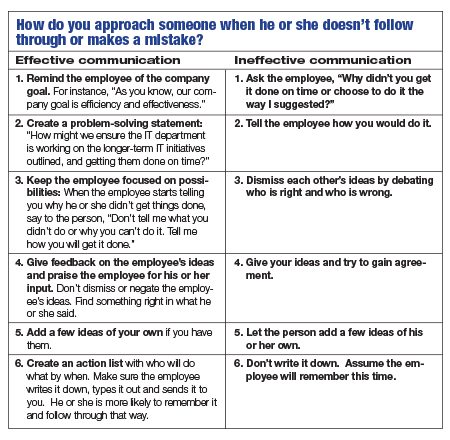Have any of your employees ever agreed to a deadline or task and not followed through? Have you found yourself feeling tempted to tell them how to do it, only to be met with excuses and resistance?
Leaders often complain about this communication style, which is called “passive-aggressive communication.” Passive-aggressive communication is a style of communication in which rather than being upfront and honest when questioned, the person denies and negates the truth in order to appear friendly, polite and kind. Their favorite words are: “sure,” “I’ll try,” “fine,” “whatever,” “as you wish,” “you’re the boss.”
Take for instance John, who manages Dave. Dave is an IT person with multiple project requests: Break and fix, risk mitigation, networking and long-term IT solutions. Dave never seems to have enough time to get to his long-term IT projects. He makes promises on deadline to avoid conflict and please his boss, but then does not follow through. No matter how many suggestions John gives him for better time management, project management, prioritizing or delegating, Dave has an answer and excuse to dismiss every solution John suggests.
One day in our leadership coaching, John was about to give up on Dave and fire him. Before he did, I suggested John first take an honest look at his own communication style. To self-reflect, I asked him which communication style was more like his (see chart)

John quickly smiled and admitted he took the second approach: ineffective communication. I further explained that no one likes to be put back on their heels with “Why didn’t you get ‘x’ done?” This indirect accusatory question begs an excuse, because it puts the person on the defense. When you then make your suggestions on how he or she can improve, you have told the person, indirectly, that he or she is not enough.
In order to get people to perform, we first must remind them of the goal. This aligns us on the same team as the employee, instead of creating an advisory position. Then we need to get the person’s ideas by giving him or her a problem-solving question on which to focus. This builds the person’s self-esteem and ownership when we ask his or her opinion for the solution. Instead of saying, “Why didn’t you get this done?” we need to ask, “How might you get this done?”
John now understood my saying, “What you focus on expands.” If you focus on “How might we get this done?” you expand the person’s self-esteem and the possibilities at hand. If you focus on “Why didn’t you get it done?” you expand the person’s insecurity and defensiveness.
John now understood how the first question gets the employee to focus on the goal and solve the problem at hand, while the second question insinuates blame. He was amazed at how just a little re-structuring of his approach and communication could make a huge difference.
I told him, “We call it lead-er-ship, not tell-er-ship because ‘What is taught is caught.’” If you ever miss a deadline and have excuses for it, you are teaching your employees that excuses are acceptable. First and foremost, make your word and commitment your honor. It is hard to hold someone accountable for a behavior if you are not already mastering it.
Challenge:
If an obstacle should get in your way and it looks as though you might miss a deadline, gather your team together and share the obstacle and ask, “How might we meet the goal with this new obstacle in mind?” Do not wait, be passive and disappoint them. By demonstrating your ability to be assertive, open and collaborative, you show your employees that together, you can overcome any obstacle.
-Susan K. Wehrley is an executive coach and business consultant who helps leaders and their employees align to organizational goals. She is the author of six books, including her newest, “EGO at Work.” You can visit her website at www.BIZremedies.com or reach her by email at susan@solutionsbysusan.com. Her phone number is (414) 581-0449.


